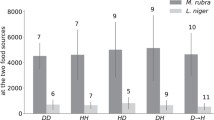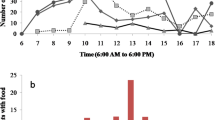Summary
Observations and field experiments on the foraging behaviour of individual workers of Cataglyphis bicolor in a Southern Tunisian shrub desert are reported. The workers search singly for their food (mostly animal carcasses) and are singleprey loaders. The individuals differ to a great extent in their persistence to re-search the place of a find on a previous foraging excursion. The differences range continuously from thoroughly researching a place to just walking by. If, in an experiment, the same reward is offered farther from the nest, each ant persists more in re-searching the place than if food is offered close to the nest. In a further experiment, some individuals persisted less in searching near the former finding site if they had collected a fly than after collecting a piece of cheese. There is, however, evidence that individuals do not differ in their food preference. Persistent individuals, which re-search the place of a former find, are faster than non-persistent ones in retrieving food that is experimentally arranged in an aggregated manner. The experiment failed to demonstrate the (reverse) superiority of non-persistent individuals foraging on homogeneously distributed food. The observations of unmanipulated foraging excursions in the field suggest such an advantage for non-persistent foragers under natural conditions where food in general occurs widely dispersed. The colony as a whole retrieves more food within the same time from an experimental lay-out that is homogeneous than from an aggregated one. The behavioural differences between individuals could be caused by a training bias of the short-lived foragers, leading to a different assessment of the profitability of a searching method which implies returning to a formerly rewarding place. Thus, each worker uses the most promising behaviour according to its individual experience. Alternatively, the individually different searching methods could mainly contribute to the welfare of the colony as a whole rather than leading to a maximal short-term efficiency of each individual. In particular, the colony, disposing of only a few highly persistent foragers, could quickly exploit occasional short-lived, but unpredictible, clumps of food within its foraging range.
Similar content being viewed by others
References
Batschelet E (1981) Circular statistics in biology. Academic Press, London
Caraco T (1980) On foraging time allocation in a stochastic environment. Ecology 61:119–128
Cheverton J (1982) Bumblebees may use a suboptimal arbitrary handedness to solve difficult foraging decisions. Anim Behav 30:943–935
Emlen ST, Demong NJ (1978) Orientation strategies used by free-flying bird migrants: A radar-tracking study. In: Schmidt-Koenig K, Keeton WT (eds) Animal migration, navigation and homing. Springer, Berlin Heidelberg New York, pp 283–293
Harkness R (1979) Durations and lengths of foraging paths of Cataglyphis bicolor. Entomol Mon Mag 115:1–9
Harkness R, Wehner R (1977) Cataglyphis. Endeavour NS 1:115–121
Heinrich B (1976) The foraging specializations of individual bumblebees. Ecol Monogr 42:105–128
Krebs JR (1978) Optimal foraging: Decision rules for predators. In: Krebs JR, Davies NB (eds) Behavioural ecology. Blackwell, Oxford, pp 23–63
Krebs JR, Ryan JC, Charnov EL (1974) Hunting by expectation or optimal foraging? A study of patch use by chikadees. Anim Behav 22:953–964
McArthur RH (1972) Geographical ecology. Harper and Row, New York
Orians GH, Pearson NE (1979) On the theory of central place foraging. In: Horn DJ, Stairs GR, Mitchell RD (eds) Analysis of ecological systems. Ohio State University Press, Columbus, pp 155–177
Oster GF, Heinrich B (1976) Why do bumblebees major? A mathematical model. Ecol Monogr 46:129–133
Poole RW (1973) Introduction to quantitative ecology. McGraw-Hill, Kogakusha
Rissing SW (1981) Foraging specializations of individual seedharvesting ants. Behav Ecol Sociobiol 9:149–152
Schmid-Hempel P (1983) Foraging ecology and colony structure in two sympatric species of desert ants, Cataglyphis bicolor and Cataglyphis albicans. PhD thesis, University of Zürich
Schmid-Hempel P (in press) Life duration and turnover of foragers in the ant Cataglyphis bicolor. Oecologia (Ber)
Smith JMN (1974) The food searching behaviour of two European thrushes. II. The adaptiveness of the search patterns. Behaviour 49:1–61
Wehner R, Harkness R, Schmid-Hempel P (1983) Foraging strategies in individually searching ants, Cataglyphis bicolor (Hymenoptera, Formicidae). Akad Wiss Lit Mainz Abh Math Naturwiss K1 1:1–79
Author information
Authors and Affiliations
Rights and permissions
About this article
Cite this article
Schmid-Hempel, P. Individually different foraging methods in the desert ant Cataglyphis bicolor (Hymenoptera, Formicidae). Behav Ecol Sociobiol 14, 263–271 (1984). https://doi.org/10.1007/BF00299497
Received:
Accepted:
Issue Date:
DOI: https://doi.org/10.1007/BF00299497




